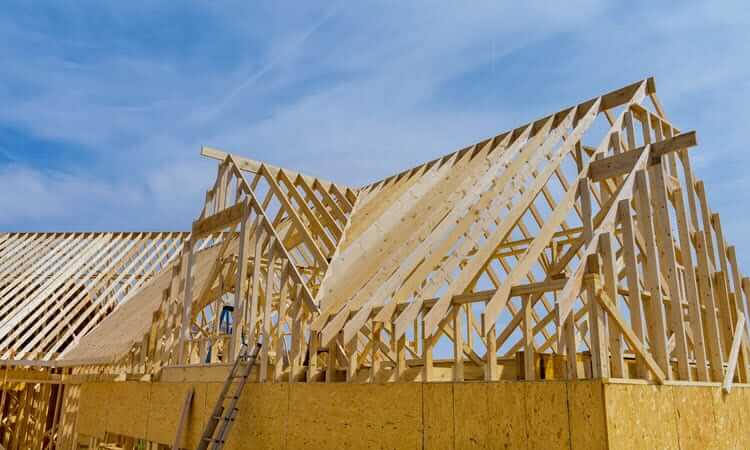Last Updated on July 31, 2023 By Emma W. Thomas
A roof framing plan is a detailed diagram showing the structural layout of a roof. It illustrates the placement, size, and spacing of rafters, trusses, beams, and other components. This plan helps builders and contractors ensure proper roof support and construction, ensuring a safe and stable roof structure.
What Is A Roof Framing Plan?
A roof framing plan is a detailed blueprint outlining a structure’s roof design and its network of components. Similar to the foundation of a building, the roof is critical as it supports the whole structure and provides protection from natural elements. A well-schematic roof framing plan is integral to ensuring a safe, secure, and enduring structure.
1. Anatomy of a Roof Framing Plan
A roof framing plan is divided into several key elements, each playing a significant role in contributing to the overall structure. This includes roof types (gable or flat), roofing materials, trusses, rafters, roof pitch, beams, ridge board, and the hip and valley system.
2. Trusses and Rafters
Particularly in residential construction, trusses, and rafters are pioneering features of a roof framing plan. Trusses are pre-fabricated structures usually made from steel or timber and provide key support. Rafters, on the other hand, are sloping beams running downhill to the roofs’ outer edge.
3. Roofing Materials and Types
Choosing the right roofing material is essential for any structure. A good roof framing plan outlines the type of roof (gable, hip, or flat), and the best complementing material, like composite shingles, asphalt shingles, or metal roofing.
4. Beams and Ridge Boards
Beams are the principal horizontal supporting element, primarily carrying vertical loads. Ridge boards are longboards that sit at the peak of the roof, where the upper ends of the rafters attach.
5. Hip and Valley System
In more complex roof framing plans, the hip and valley system becomes an essential feature. They form the junctions that occur when different roof sections intersect.
| Components | Role |
|---|---|
| Trusses and Rafters | Support elements for the roof |
| Roofing Materials and Types | Primary rooftop covering choices |
| Beams and Ridge Boards | Integral horizontal supports at the rooftop |
| Hip and Valley System | The System at the junctions of intersecting roofs |
Why Is A Roof Framing Plan Important?

A roof framing plan carries with it the structure of a roof and all its components. It would be best if you did the roof framing following the roof framing plan, or else it will fail the framing inspection. It has all the details of what will cover the roof and the ceiling. This plan is essential as it has all the construction notes, which must be adhered to and serve as a reference point. Most of the details on the notes provide information on materials to be used on the roof, nailing and screw patterns to be used, method of roof installation, underlayment, and flashings, among others.
A roof framing plan includes all dimensions, sizes, and angles of materials used in roof framing, including roof design, shape, size, and material. Having a laid-out plan before roof framing is crucial as it helps the constructor prepare both physically and mentally, making the framing process easier. It also helps to assemble all the required tools and materials with some work done before the actual framing begins. Having a ready roof framing plan leaves you with only the placing work, which is not as tricky, especially with manual laborers to help with some of the physical work.
Who Uses The Roof Framing Plan?
The contractors mostly use the roof framing plan, but you can ask them any questions about the roof framing work as the project owner. It helps you understand the roof framework better and make changes where necessary. Sometimes, local officials require a roof framing plan and roof plan to get permission for project completion. In such a case, coming up with one is very important to prevent delays in completing the project associated with the local authorities.
What Should You Know When Making A Roof Framing Plan?
In most cases, a roof framing plan depends on the type and style of roof used in a house. There are different roof types, and their roof frame plan and construction differ. Rooftops add attractiveness to a home, and the style used brings out a different effect. Some are more sloping than others, with varying levels of challenges during their construction. The following are some of the roof styles considered before coming up with a framing plan;
Gable Roof Style
Gable roof style is a roof style with two sloping sides that meet at the top, forming a roof. A gable is a triangular wall enclosed by two sloping ends of a roof. A gable roof style usually has dormers or upright window projections for increasing the amount of light entering the building. They also serve as secondary ventilation to the upper floor rooms and the attic.
Hip Roof Style
A hip roof is a style that slopes on both sides and ends of the building. These slopes result in an even overhang around the house, creating a low appearance. Such roofing styles require low levels of maintenance since there are no sidings above the overhang parts. The hip roof style is solid and should be used in areas that experience severe storms.
Low Slope Roof Style
This style is also known as the flat roof, even though it is not perfectly balanced. The rafters used on flat roofs laid to a slight angle are for water-draining purposes only. You should apply the ceiling materials on the rafters’ underside Since it is difficult to maintain a moisture-free flat roof. Sheathing and roofing, on the other hand, spread on top of the rafters. Such roof types are better if used in dry climates.
Shed Roof Style
It is also known as a lean-to roof as it slopes only in one direction. You use it as a secondary roof by adding it to an existing one. Sometimes, you can attach it to the sides of the building structure or the existing roof.
Gambrel Roof Style
The gambrel style is a variation of the gable roof style having steep slopes on two sides. This technique involves a second slope beginning partway up and continuing to the topmost part of the building. Such roofing styles are common in barns as they leave more attic space and can serve as a second floor which is not the case with gable and hip roof styles.
Mansard Roof Style
This roof style is a variation of the hip roof style with steep slopes on all four sides. On the way up, a second shallow slope is developed and goes all the way to the top, where it meets slopes from the other three sides. Mansard roof style was introduced to the North Americans by the French who settled in Quebec, Canada.
Dutch Hip Roof Style
This pattern combines both the gable and hip roof styles. It is a hip roof style with small gable styles on each end near the topmost parts of the roof. The style has an even overhang around the structure which protects the building walls from rain.
What Are The Standard Terms Used In A Roof Framing Plan?
Some terms used in a roofing plan are primarily parts of the roof. Mastering such terms makes it easier to understand roof framing concepts. Some of the words include;
Rafters
It is an inclined part of the roof framework serving the same purpose as joists in the roof. You lay the rafters 16-24 inches apart. Their difference depends on their length, spacing distance, slope, and the type of roof style to be used. There are various types of rafters, depending on the type of roof style.
Collar Tie
It is a horizontal tie connecting opposite pairs of rafters whose purpose is to stiffen the roof.
A Ridge Board
A ridge board is a horizontal piece connecting the upper parts of rafters giving a house its full-length extension.
Common Rafters
Common rafters stretch from the top plate to the ridge board at a 90 degrees angle.
Hip Rafters
These rafters extend diagonally from a corner formed by two top plates to the ridge board. They are used in hip roof style.
Jack Rafters
Jack rafters do not extend fully from the top plate to the ridge board like other rafters. They come in three types; hip jack rafters, valley jack rafters, and cripple jack rafters.
How Do You Layout A Roof Framing Plan?

Before cutting out any materials used for the roof, you must determine the kind of rafters used in framing a roof. All these details in the roof framing plan have the relevant information needed, including the roofing style. It also dictates the type of rafters to be used and all other required materials. Each roof style has a different roof framing plan. The following is an illustration of how you layout a roof framing plan for different roof styles;
Gable Roof Style
The Gable roof style has the most straightforward framing plan compared to other roof styles. It involves the following;
- Begin by laying out the outline of the structure. You can label it as (A)
- Determine the direction the rafters will run
- Draw a centerline at 90 degrees angle(B) with the direction which will determine the location of the ridgeline(C)
- Decide on the distance between the rafters(D).
- Layout the roof frame plan
Hip Roof
Hips used in the hip roof style extend from each other at an angle of 45 degrees, but other angles are possible. A 450 angle ensures a uniform slope for all the roof surfaces, which is not the case with different angles. Laying a roof framing plan for a hip roof style involves;
- Begin by laying out the outline of the building(A)
- Draw a centerline(B)
- From each corner to the centerline, draw lines at 45 degrees(C) to establish the location of the hip rafters.
- At the intersecting points of the hip rafters, draw the ridgeline and label it (D)
Depending on the building size, determine the gap between raters and lay them out on the roof framing plan.
The roof frame planning process is the same as all the other roof styles with slight differences, such as on the rafters’ angle of inclination. However, some such as hip and valley roof styles can be complex as they involve more than one hip roof intersecting at 900 pitches.
Conclusion
A roof framing plan is a necessity when roofing any building. It contains essential information such as the type of roof to be used and the materials. It also lays out the measurements, dimensions, and sizes of the framing requirements, including the angles involved. It helps both the contractor and the project owner prepare all the important tools and materials for the roof framing work.
References:
https://www.edrawmax.com/article/what-is-roof-framing-plan.html
https://plasticinehouse.com/roof-framing-plan/
Emma is a graduate of Domestic Science or Family and Consumer Sciences (Home Economics) from the University of Wisconsin. She has 7 years of experience Working with the strategic section of BestBuy and now writing full-time for Homeeon.
From Managing the Home, Interiors, Cleaning, and Exteriors to Gardening and everything about Making A Home Liveable – is her passion and this Homeeon is the result of this.
Emma loves decorating her home with the best stuff found online. She cares about quality over anything and writes reviews about them here in Homeeon. Get in touch with her over Pinterest.
Keep reading her blogs.

